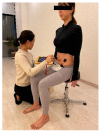Effect of Pelvic Floor Muscle Training Using Pressure Biofeedback on Pelvic Floor Muscle Contraction and Trunk Muscle Activity in Sitting in Healthy Women
- PMID: 35327048
- PMCID: PMC8953122
- DOI: 10.3390/healthcare10030570
Effect of Pelvic Floor Muscle Training Using Pressure Biofeedback on Pelvic Floor Muscle Contraction and Trunk Muscle Activity in Sitting in Healthy Women
Abstract
Pelvic floor muscle training (PFMT) has been recommended as the first choice as one of the effective methods for preventing and improving urinary incontinence (UI). We aimed to determine whether pressure biofeedback unit training (PBUT) improves short term and retention performance of pelvic floor muscle contraction. The muscle activities of the external oblique (EO), transversus/internal oblique (TrA/IO), multifidus (MF) and the bladder base displacement were measured in the verbal feedback group (n = 10) and PBU group (n = 10) three times (baseline, post-training, and at the 1-week follow-up). Surface electromyographic activity was recorded from the EO, TrA/IO, and MF muscles. The bladder base displacement was measured using ultrasound. The results were analyzed using two way mixed ANOVA. The bladder base displacement may have elevated more in the PBU group than in the verbal feedback group due to decreased TrA/IO activity. These findings indicate that PBUT is a better method than verbal feedback training.
Keywords: pelvic floor muscle training; pressure biofeedback; trunk muscles; verbal feedback.
Conflict of interest statement
The authors declare no conflict of interest.
Figures
References
-
- Haylen B.T., de Ridder D., Freeman R.M., Swift S.E., Berghmans B., Lee J., Monga A., Petri E., Rizk D.E., Sand P.K., et al. An International Urogynecological Association (IUGA)/International Continence Society (ICS) joint report on the terminology for female pelvic floor dysfunction. J. Int. Urogynecol. 2010;21:5–26. doi: 10.1007/s00192-009-0976-9. - DOI - PubMed
-
- Abreu N.S., Baracho E.S., Tirado M.G.A., Dias R.C. Quality of life from the perspective of elderly women with urinary incontinence. Braz. J. Phys. Ther. 2007;11:429–436. doi: 10.1590/S1413-35552007000600003. - DOI
-
- Moore K.N., Valiquette L., Chetner M.P., Byrniak S., Herbison G.P. Return to continence after radical retropubic prostatectomy: A randomized trial of verbal and written instructions versus therapist-directed pelvic floor muscle therapy. Urology. 2008;72:1280–1286. doi: 10.1016/j.urology.2007.12.034. - DOI - PubMed
LinkOut - more resources
Full Text Sources



